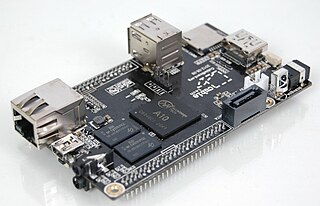
The OMAP family, developed by Texas Instruments, was a series of image/video processors. They are proprietary system on chips (SoCs) for portable and mobile multimedia applications. OMAP devices generally include a general-purpose ARM architecture processor core plus one or more specialized co-processors. Earlier OMAP variants commonly featured a variant of the Texas Instruments TMS320 series digital signal processor.

The Texas Instruments DaVinci is a family of system on a chip processors that are primarily used in embedded video and vision applications. Many processors in the family combine a DSP core based on the TMS320 C6000 VLIW DSP family and an ARM CPU core into a single system on chip. By using both a general-purpose processor and a DSP, the control and media portions can both be executed by separate processors.
The i.MX range is a family of Freescale Semiconductor proprietary microcontrollers for multimedia applications based on the ARM architecture and focused on low-power consumption. The i.MX application processors are SoCs (System-on-Chip) that integrate many processing units into one die, like the main CPU, a video processing unit, and a graphics processing unit for instance. The i.MX products are qualified for automotive, industrial, and consumer markets. Most of them are guaranteed for a production lifetime of 10 to 15 years.
Devices that use i.MX processors include Ford Sync, the Amazon Kindle and Kobo eReader series of e-readers until 2021, Zune, Sony Reader, Onyx Boox readers/tablets, SolidRun SOM's, Purism's Librem 5, some Logitech Harmony remote controls and Squeezebox radio and some Toshiba Gigabeat MP4 players. The i.MX range was previously known as the "DragonBall MX" family, the fifth generation of DragonBall microcontrollers. i.MX originally stood for "innovative Multimedia eXtension".

The ARM Cortex-A9 MPCore is a 32-bit multi-core processor that provides up to 4 cache-coherent cores, each implementing the ARM v7 architecture instruction set. It was introduced in 2007.

The ARM Cortex-A15 MPCore is a 32-bit processor core licensed by ARM Holdings implementing the ARMv7-A architecture. It is a multicore processor with out-of-order superscalar pipeline running at up to 2.5 GHz.

Exynos, formerly Hummingbird (Korean: 엑시노스), is a series of ARM-based system-on-chips developed by Samsung Electronics' System LSI division and manufactured by Samsung Foundry. It is a continuation of Samsung's earlier S3C, S5L and S5P line of SoCs.
The Cotton Candy is a very small, fanless single-board computer on a stick, putting the full functions of a personal computer on a device the size of a USB memory stick, manufactured by the Norwegian-based hardware and software for-profit startup company FXI Technologies.

The Allwinner A1X is a family of single-core SoC devices designed by Allwinner Technology from Zhuhai, China. Currently the family consists of the A10, A13, A10s and A12. The SoCs incorporate the ARM Cortex-A8 as their main processor and the Mali 400 as the GPU.
The MK802 is a PC-on-a-stick produced by Rikomagic, a Chinese company using mostly two series of Systems on a chip architectures:

A stick PC or PC on a stick is a single-board computer in a small elongated casing resembling a stick, that can usually be plugged directly into an HDMI video port. A stick PC is a device which has independent CPUs or processing chips and which does not rely on another computer. It should not be confused with passive storage devices such as thumb drives.
Telechips(텔레칩스) is a fabless company headquartered in Seoul, founded in 1999 with regional offices in Japan (Tokyo), China, USA, Germany (Munich) and Singapore that designs integrated circuits.

Allwinner Technology Co., Ltd is a fabless semiconductor company that designs mixed-signal systems on a chip (SoC). The company is headquartered in Zhuhai, Guangdong, China. It has a sales and technical support office in Shenzhen, Guangdong, and logistics operations in Hong Kong.

Banana Pi is a line of single-board computers produced by the Chinese company Shenzhen SINOVOIP Co., Ltd., its spin-off Guangdong BiPai Technology Co., Ltd. and supported by Hon Hai Technology (Foxconn).

Amlogic Inc. is a fabless semiconductor company that was founded on March 14, 1995, in Santa Clara, California and is predominantly focused on designing and selling system on a chip integrated circuits. Like most fabless companies in the industry, the company outsources the actual manufacturing of its chips to third-party independent chip manufacturers such as TSMC. Its main target applications as of 2021 are entertainment devices such as Android TV-based devices and IPTV/OTT set-top boxes, media dongles, smart TVs and tablets. It has offices in Shanghai, Shenzhen, Beijing, Xi'an, Chengdu, Hefei, Nanjing, Qingdao, Taipei, Hong Kong, Seoul, Mumbai, London, Munich, Indianapolis, Milan, Novi Sad and Santa Clara, California.

SolidRun is an Israeli company producing Embedded systems components, mainly mini computers, Single-board computers and computer-on-module devices. It is specially known for the CuBox family of mini-computers, and for producing motherboards and processing components such as the HummingBoard motherboard.

Tensor Processing Unit (TPU) is an AI accelerator application-specific integrated circuit (ASIC) developed by Google for neural network machine learning, using Google's own TensorFlow software. Google began using TPUs internally in 2015, and in 2018 made them available for third party use, both as part of its cloud infrastructure and by offering a smaller version of the chip for sale.
S5P4418 is a system-on-a-chip (SoC) based on the 32-bit ARMv7-A architecture developed by Samsung Electronics for tablets and cell-phones

GPD XD is an Android-based handheld game console produced by the Chinese company GamePad Digital, released in late 2015. It is similar in form to a Nintendo 3DS XL, has a single, capacitive touch-screen, and is optimized for running emulators and other native Android software. It was succeeded by the GPD XD Plus, which has a smoother hinge and runs on Android 7.














